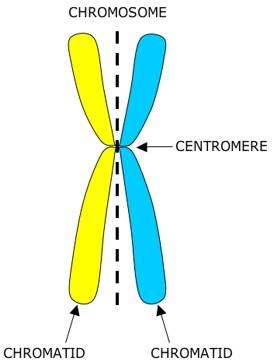Daily Newsletter
October 29, 2013 Chromosomes
Chromosomes
The word chromosome has a number of common means, but as biologists we need a strong (strict) definition of the word. For a biologist, a chromosome is a single molecule of DNA with associated packaging proteins, and is visible only during Metaphase and Anaphase of nuclear division. This second part is important; the chromosome is visible under light microscopy (the common form of microscopy). The chromosome is visible because it condenses (becomes tightly packed) during nuclear division (thus it is a eukaryotic phenomena).We use the term chromosome to refer to a single molecule of DNA, but remember, in the strict sense, it only refers to a visible arrangement of DNA and proteins seen during nuclear division.
Another loose use is referring to the single, circular DNA molecule found in bacteria (or other prokaryotic DNA). As bacterial DNA is not held by the same packaging proteins, and has different packaging issues, the use of chromosome in this case is in error. The term genophore is a more appropriate term for prokaryotic DNA.
In eukaryotes, DNA must be packaged. One reason for this is to prevent physical strain or damage to the DNA molecule. The second reason is to conserve space. DNA is just too large when it is not packaged. The basic unit of DNA packaging is nucleosome. The nucleosome is a unit of packaged DNA, in which the DNA molecule is wrapped 1.67 times (~147 base pairs) around a core of 8 positively charged histone molecules (positive charge attracts negative phosphates).
These histone cores, when associated with Histone1 can begin to supercoil into a fiber. A cascade of interactions causes more supercoiling which ultimately forms the chromosome.
The chromosome when it first forms during prophase of nuclear division is actually two freshly replicated molecules of DNA (we just copied DNA). The image below is a single chromosome composed of two sister chromatids:
Notice that the two sides of the Chromosome are individual DNA molecules that we refer to as Chromatids. Holding the two chromatids together is a protein rich region known as the centromere. At the centromere, we will find a molecular motor known as the kinetochore. We will see the operation of the kinetochore during cell division.
NOTE: You have some words here that sound familiar and often get confused. In your notes, make sure you have definitions of Chromosome and Chromatid. Work on using these terms correctly.
Here is a video to help you visualize the process: How DNA is Packaged
Daily Challenge
In your own words, describe how DNA is packaged into a chromosome. Why is it important that we package DNA at the nucleosome and chromosome level?Other resources:





No comments:
Post a Comment